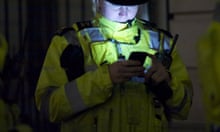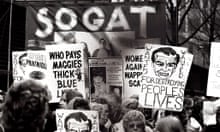The home secretary has ordered police forces to delete on request millions of images of innocent people unlawfully retained on a searchable national police database.
A Home Office review published on Friday found that police forces make extensive use of more than 19m pictures and videos, known as custody images, of people they have arrested or questioned on the police national database.
Despite a high court ruling in 2012 that keeping images of innocent people was unlawful, police forces have quietly continued to build up a massive database without any of the controls or privacy safeguards that apply to police DNA and fingerprint databases.
The review, ordered by ministers in the wake of the high court ruling, found five years ago that more than 16m images had been enrolled in the facial recognition gallery on the police national database making it possible to search them using facial recognition technology.
Amber Rudd said in a statement that officers make extensive use of custody images and they are now a standard feature of everyday policing as frontline officers use them to identify suspects, offenders and those on bail.
“The review acknowledges the important role that custody images and facial searching plays in the detection and prevention of crime. However, it recognises the need to strike a careful balance between protecting individual privacy and giving the police the tools they need to keep us safe.
“Accordingly, following consultation with key partners, the principal recommendation is to allow ‘unconvicted persons’ to apply for deletion of their custody image, with a presumption that this will be deleted unless retention is necessary for a policing purpose and there is an exceptional reason to retain it,” said the home secretary.
“In practice, this will mean that people could apply to chief officers for their image to be deleted where they have not been convicted of the offence in relation to which their image was taken.” In the case of children under 18 chief constables will have to have a “highly exceptional reason” to refuse deletion.
The Home Office said it was impractical to insist police forces go through all 19m images and delete those of people who were not convicted of an offence.
“The police national database does not link custody images to individual crime records. Therefore such an exercise would require forces to review all of the images they hold which would be extremely lengthy and resource intensive. It would also cost a very considerable amount of taxpayers’ money,” it said.
The human rights group Liberty, party to the original case in 2012, said the government’s much delayed response fell short of what was needed.
Bella Sankey, Liberty’s policy director, said: “The Home Office has been knowingly breaching the law for years – and all they’ve finally managed to come up with is a cop-out.
“Police hold thousands of pictures of activists and bystanders who were never even taken into custody and may not know their photo was taken. That was ruled unlawful – yet this report fails to address it entirely. And those who have been arrested but are no longer suspected should not have to ask for their images to be deleted – it should happen automatically.
“We don’t need wishy-washy recommendations. We need changes to the law so photo retention – like DNA and fingerprint storage – is properly regulated, and innocent people’s rights are properly respected.”
Renate Samson, of Big Brother Watch, said: “Whilst the opportunity for people to have their custody photo deleted from the database is welcome, we believe they shouldn’t have to ask, it should be an automatic process. The explanation as to why this can’t be done reveals a poorly designed IT system which is impacting innocent people’s right to privacy. A system should be created whereby those who are found to be innocent have their images deleted automatically, as is the case with DNA and fingerprints.”
The Home Office review also recommended that ex-offenders who were convicted of their offence or released from prison six to 10 years ago – depending on the type of offence – could also apply for their custody images to be deleted, but it would be left to police discretion whether to keep the images on record or not.
The 19m pictures only cover those who have been photographed by the police after being arrested and taken to a custody suite. The database does not include images acquired by police in other ways, such as CCTV footage of demonstrations. The database also includes multiple pictures of single individuals. Nevertheless, the biometrics commissioner has estimated that it includes images of “hundreds of thousands of individuals who have never been charged with, let alone convicted of, an offence”.
The review said that in March 2015 the number of images stored by the police ranged from 26,816 in the smallest force to 7.8m in the largest. They are most commonly used to brief frontline officers so they can identify suspects, offenders and those on bail. The custody images are also used in investigations to identify witnesses and help with searching for unidentified suspects.
Concerns over the lack of controls or safeguards have also been raised by the Commons science and technology committee. As home secretary Theresa May put strong deletion policies in place for innocent people in the national DNA and fingerprint databases through the Protection of Freedoms Act 2012.




